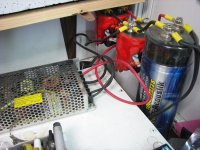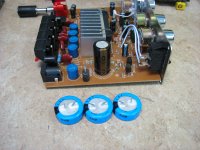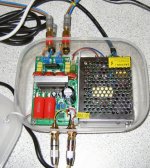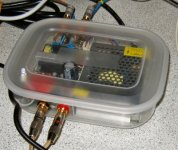Hi Roma. The 2020 will work well with pretty much any speakers, it is not too fussed by difficult loads etc, but you won't get much volume unless they are reasonably efficient.
Anything over 90 db per watt will probably give enough volume for virtually all purposes.
These amps will be a great match for efficient single driver systems and I imagine they would work particularly well with horn loaded systems, have a look at the one of the forums that specialize in single driver systems, there are a huge array of possibilities and many are quite cheap.
Anything over 90 db per watt will probably give enough volume for virtually all purposes.
These amps will be a great match for efficient single driver systems and I imagine they would work particularly well with horn loaded systems, have a look at the one of the forums that specialize in single driver systems, there are a huge array of possibilities and many are quite cheap.
I have the transmission line version of the doctor ks and like them very much. The guy uses "average mans" components for the cross over so its relativity cheap compaired to the designs that have 3x the cost of the drivers in just the crossover. Please remember that this model has some deep bass but recessed vocals.
Before you dive into the $800 kit if this is going to be a first timer build, i would get the $200 trix to start you off. I have these as well and they are a great party speaker that are well manured.
Parts Express DIY Project
If you can make your own cabinet I highly recomend the new black box. It has their new sealed mid and a nice single 10" woofer, all in a small sealed cab. Very clean sounding.
Parts Express DIY Project
Before you dive into the $800 kit if this is going to be a first timer build, i would get the $200 trix to start you off. I have these as well and they are a great party speaker that are well manured.
Parts Express DIY Project
If you can make your own cabinet I highly recomend the new black box. It has their new sealed mid and a nice single 10" woofer, all in a small sealed cab. Very clean sounding.
Parts Express DIY Project
The 10" ones can be made for half the price if you just use dayton audio caps and coils (he uses $400 in just high end 200uf caps) so thats in your budget.
The trix can be ordered with just the kit without the boxes for $120 a pair, then select the mtm cabinets from the doctor K's and you have a nice silk dome setup for less then half the price.
Yes the 10" is a little low on the efficiency end, but if you look at the charts its extremely flat and a very small box. Also he does 1w1m, if you did the other standard of 2.83V/1m it would be 88db. And he has a small room...
The trix can be ordered with just the kit without the boxes for $120 a pair, then select the mtm cabinets from the doctor K's and you have a nice silk dome setup for less then half the price.
Yes the 10" is a little low on the efficiency end, but if you look at the charts its extremely flat and a very small box. Also he does 1w1m, if you did the other standard of 2.83V/1m it would be 88db. And he has a small room...
Thanks for your help. I will go with second setup, I like Doctor K's box more.The 10" ones can be made for half the price if you just use dayton audio caps and coils (he uses $400 in just high end 200uf caps) so thats in your budget.
The trix can be ordered with just the kit without the boxes for $120 a pair, then select the mtm cabinets from the doctor K's and you have a nice silk dome setup for less then half the price.
Yes the 10" is a little low on the efficiency end, but if you look at the charts its extremely flat and a very small box. Also he does 1w1m, if you did the other standard of 2.83V/1m it would be 88db. And he has a small room...
Hope this setup will sound good, because this speakers looks cheap to me..
May be I can install to this box better drivers? Any ideas? Sorry for all questions, I'm new here. Any advice is appreciated.
It all depends on what sound you like. Its a love hate with the reference r28 tweeter in the dr k's. Alot of people wont use it because it wont behave in some setups. In other setups it sounds very good if the proper cross over is used.
In terms if the trix sounds good. Its in rev 3 right now and has been kicking **** for 10 years now and is a proven setup.
If you want something inbetween the $800 reference setup and the $200 classic series, you could try the aluminum type such as the DA175-8 and DC25TS-8.
Other then that you could just get a kit $350:
Parts-Express.com ayton RS621BK Speaker Kit Pair Gloss Black | speaker kit kit rs621 monitor speaker two way speaker monitor Encore speakersubwooferkits
ayton RS621BK Speaker Kit Pair Gloss Black | speaker kit kit rs621 monitor speaker two way speaker monitor Encore speakersubwooferkits
Its just a dr k with 1 6" woofer instead of 2 7" woofers.
In terms if the trix sounds good. Its in rev 3 right now and has been kicking **** for 10 years now and is a proven setup.
If you want something inbetween the $800 reference setup and the $200 classic series, you could try the aluminum type such as the DA175-8 and DC25TS-8.
Other then that you could just get a kit $350:
Parts-Express.com
Its just a dr k with 1 6" woofer instead of 2 7" woofers.
Arjen doesn't include schematics, but I think they're available in past threads here and he's quite good about getting back to you about specific questions.
I've now built 3 of the 2020 boards and have been very pleased. I matched one to a Sony ES player from the early 90's and a 2 way set of speakers using an accuton ceramic tweeter and a cabase 6.5" woofer in a corian pyramid and was genuinely shocked. I'd thought of my speakers as an expensive failure, but they're a great match for the 2020.
What was the sp. ft. on the 6" enclosure, if you don't mind me asking? I'm trying to box up two 6.5" full range speakers, but don't know how much room they need...
Thanks,
Nicholas G.
I think I used 24 liters which is like 7/8 of a square foot. You then have to subtract the size of the drivers inside the box, the vent, the crossover (if it's inside) etc. to get a volume. The figure's not going to help you though unless you're working with an identical woofer.
You might want to google Thiele/Small parameters T/S if you're going with a vented or ported enclosure. It'll give you some sense of how box volume, port size, and driver interrelate. I think it's still in print, Vance Dickason wrote a very straightforward guide to DIY loudspeaker design many years ago. It's also a good place to start.
My one lesson after years of doing this is that it's cost me way more not less to do it myself with my projects, but I've learned more and had more fun in the process. I made so many mistakes when I had no idea I was making a mistake, bought things I never used, etc.
You might want to google Thiele/Small parameters T/S if you're going with a vented or ported enclosure. It'll give you some sense of how box volume, port size, and driver interrelate. I think it's still in print, Vance Dickason wrote a very straightforward guide to DIY loudspeaker design many years ago. It's also a good place to start.
My one lesson after years of doing this is that it's cost me way more not less to do it myself with my projects, but I've learned more and had more fun in the process. I made so many mistakes when I had no idea I was making a mistake, bought things I never used, etc.
I received my Arjen Helder TA2020MkIII amp last weekend and assembled the connections a few days. For volume control, I tried a 50k SMD stepped attenuator. When I tried out the amp, the volume at the first volume level step is extremely loud and distorted. Even when the stepped attenuator is set to zero, I can faintly hear sound coming out. Thinking that maybe the stepped attenuator was faulty, I replaced it with a 50k Panasonic EVJ volume pot. I still get the same response.
Looking from the top of the PCB, the connections I've made are as follows:
O O O
R GND R Out R In
O O O
O O O
L GND L Out L In
I've wired volume pots and stepped attenuators in other amp projects before, but am I missing something here, or did I get a defective amp? Any help is greatly appreciated.
Looking from the top of the PCB, the connections I've made are as follows:
O O O
R GND R Out R In
O O O
O O O
L GND L Out L In
I've wired volume pots and stepped attenuators in other amp projects before, but am I missing something here, or did I get a defective amp? Any help is greatly appreciated.
I have one here with a V2 pcb, and there are small tracks linking the "in" and wiper tracks on the bottom of the board. If you're wiring into the pcb you would need to cut those. Otherwise wire the pot external to the board and just connect wiper and ground from the pot to the pcb. The "in" connection on the pot coming directly from your source connector.
I have one here with a V2 pcb, and there are small tracks linking the "in" and wiper tracks on the bottom of the board. If you're wiring into the pcb you would need to cut those. Otherwise wire the pot external to the board and just connect wiper and ground from the pot to the pcb. The "in" connection on the pot coming directly from your source connector.
gazzagazza,
Thanks for the tip. I might try wiring the pot directly from the RCA inputs and connect the wiper and ground connections to the board.
Thanks again.
gazzagazza,
You were right! The board has the same traces connecting the input thru-holes with the output or wiper thru-holes. I just wired the input RCA connectors directly to the volume pot as you suggested. I didn't want to disconnect the traces in case I use this as a power amp for future use. Thanks again for the help. It's working fine now. Once I burn in the amp, I'll share my listening impressions.
You were right! The board has the same traces connecting the input thru-holes with the output or wiper thru-holes. I just wired the input RCA connectors directly to the volume pot as you suggested. I didn't want to disconnect the traces in case I use this as a power amp for future use. Thanks again for the help. It's working fine now. Once I burn in the amp, I'll share my listening impressions.
Power supply suggestions
I have been playing with the 2020 triamps for a little while and what I did for the powersupply was get a 5 amp switching supply and hook it to a 1 farad capacitor usually used in car amps. big huge thing with a digital voltage readout. What I noticed when turning the volume up on the amps it would actually pull the voltage down on that big capacitor. But you get tons of bass. So since it was still draining the cap at high volumes I purchased two more capacitors like that for a total of 3 farads and put a 7 amp supply there to keep them charged. Now when I turn the volume up there is no voltage drop on the capacitor. So I am thinking those little tiny capacitors you guys are using on your power supplies is the main reason you dont get much bass. I get tons of bass. floor thumping heavy deep bass. I can get a 25 hz sine wave to show up on tests.
My system has two amps, one for the main speakers and one amp for the sub woofers and floor thumpers.
On the main amp I have two 23 inch flat panel speakers(closeouts at parts express), and planar tweeters and two 10 inchers in speaker boxes. lovely sound.
The sub amp has one 12 inch speaker and two floor thumpers and a small center channel speaker which I keep turned down. Music comes out of computer on seperate channels, also will be working on the back channels eventually with a third amp.
I have been playing with the 2020 triamps for a little while and what I did for the powersupply was get a 5 amp switching supply and hook it to a 1 farad capacitor usually used in car amps. big huge thing with a digital voltage readout. What I noticed when turning the volume up on the amps it would actually pull the voltage down on that big capacitor. But you get tons of bass. So since it was still draining the cap at high volumes I purchased two more capacitors like that for a total of 3 farads and put a 7 amp supply there to keep them charged. Now when I turn the volume up there is no voltage drop on the capacitor. So I am thinking those little tiny capacitors you guys are using on your power supplies is the main reason you dont get much bass. I get tons of bass. floor thumping heavy deep bass. I can get a 25 hz sine wave to show up on tests.
My system has two amps, one for the main speakers and one amp for the sub woofers and floor thumpers.
On the main amp I have two 23 inch flat panel speakers(closeouts at parts express), and planar tweeters and two 10 inchers in speaker boxes. lovely sound.
The sub amp has one 12 inch speaker and two floor thumpers and a small center channel speaker which I keep turned down. Music comes out of computer on seperate channels, also will be working on the back channels eventually with a third amp.
vzon,
Thanks for the tip. I'm not a car audio enthusiast, but this looks pretty interesting. Besides heavier bass, can you comment on any other improvements in the sound quality?
Thanks,
I cant say for sure any other improvements. I did take some photos of the capacitors and another option for inside the Amplifier case. Here are the photos of the car caps hooked in parallel and the 7 amp power supply that keeps them fed, and that setup feeds 2 Lepai 2020 amps.
And also a photo of some ultra capacitors to show how small they are.
the three blue capacitors are 1 farad each but only 5.5 volts so you have to hook 3 in series to bring the voltage up to 16.5 volts. the capacitance is now 333,333 uf, which is over 100 times the value of the capacitor that is on the board inside the amp which is only 3300 uf.
Another point also. it takes 9 of the ultra capacitors hooked in series parallel to make teh equivalent capacity as one of those large car capacitors. Which a little moding one could fit 9 of the ultracapcitors into the amp case.
Any way these are some ways to beef up the power supplies of the Lepai 2020 running at 12 volts.
Attachments
Hi Guys!!!
I was searching for a nice TA2020 amp on ebay and i found out that there are like thousands of them now.
I would like to know which ones really shine in terms of quality and are the best for the price?[/QUOTE
Hi all. This is my first post here, spent quite a bit of time lurking and have just taken my first foray into DIY. I just put together one of Arjen Helder's MKIII TA2020's, I built it inside a £0.65 plastic lunchbox as I did not want to spend money until I knew it could out perform the off the shelf versions from the likes of Topping.
I started my love affair with T Amps nearly two years ago with a Trends TA 10.1, then moved on to two Topping TP-10 MKII's to Bi-Amp a pair of B&W's for my desktop system, I purchased a HLLY TAMP 90 for a bedroom system and finally a Topping TP21 for a bathroom system. So I am in a good position to help answer the original posters question, so IMHO in descending order of sound quality :-
Arjen's TA2020
Topping TP21
Topping TP-10 Trends TA 10.1 (joint third)
.
.
.
.
.
HLLY TAMP 90
You can fill in the gaps with all the stuff that one hopes has to be better than the HLLY, as quite frankly it's bloody awful. For off the shelf I like Topping, from what I have seen on forum postings they do take note of what modders are up to. It's interesting that Arjen has chosen to sell the Topping TP20 MKII as his off the shelf offering.
As for my first DIY project it will be coming out of the lunchbox and into a proper case along with one of Arjen's tube buffers. More than likely I will build another one but containing two MKIII TA2020's, to replace my current Bi-Amped Topping TP-10's.
Attachments
Hi Vzon,
Have you checked that your SMPS is happy with that level of capacitance sitting on it's output? Hopefully all is fine, but you can't take it for granted that the SMPS is happy.
If you want better bass with these amps the MOST important thing to do is to replace the input coupling caps with bigger better ones. Assuming the input impedance in 20Kohms (my guess), The supplied 2.2uF caps will make the bass -3dB at 3.6Hz but phase issues will be present up to at least 36Hz. You need to double this capacitance for improved bass response - try 4.7uF as a common value. But remember the rule for caps in series: if your source has an output coupling cap this may also be rolling off the bass. Personally I would go with 8-10uF industrial polypropylene in oil input caps to minimise issues with source output caps.
Rhing, assuming the amp board input impedance is indeed around 20Kohm try a 10Kohm attenuator instead of the 50Kohm. Ideally you would want a passive attenuator to be a tenth of the impendance of your amp input, but going down to 2Kohm would place too much load on your sources output. 10Kohm should be fine (much better dynamics and bass than 50Kohm).
Have you checked that your SMPS is happy with that level of capacitance sitting on it's output? Hopefully all is fine, but you can't take it for granted that the SMPS is happy.
If you want better bass with these amps the MOST important thing to do is to replace the input coupling caps with bigger better ones. Assuming the input impedance in 20Kohms (my guess), The supplied 2.2uF caps will make the bass -3dB at 3.6Hz but phase issues will be present up to at least 36Hz. You need to double this capacitance for improved bass response - try 4.7uF as a common value. But remember the rule for caps in series: if your source has an output coupling cap this may also be rolling off the bass. Personally I would go with 8-10uF industrial polypropylene in oil input caps to minimise issues with source output caps.
Rhing, assuming the amp board input impedance is indeed around 20Kohm try a 10Kohm attenuator instead of the 50Kohm. Ideally you would want a passive attenuator to be a tenth of the impendance of your amp input, but going down to 2Kohm would place too much load on your sources output. 10Kohm should be fine (much better dynamics and bass than 50Kohm).
- Status
- This old topic is closed. If you want to reopen this topic, contact a moderator using the "Report Post" button.
- Home
- Amplifiers
- Class D
- Best TA2020 Amp On Ebay



